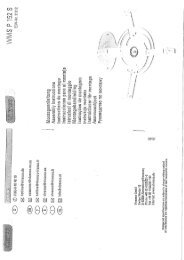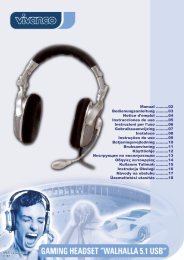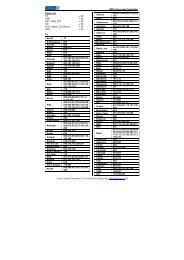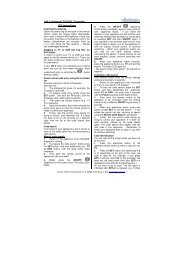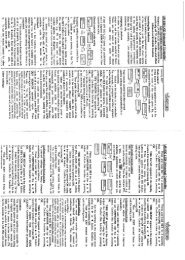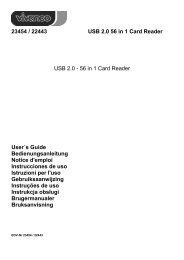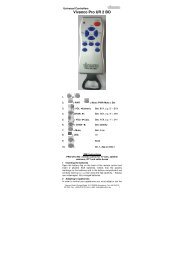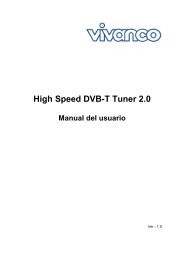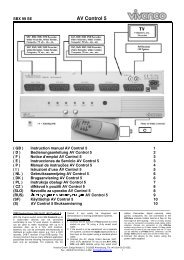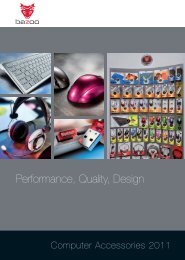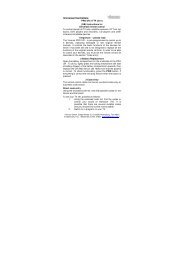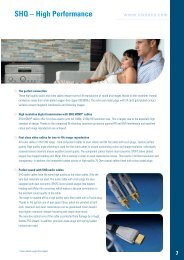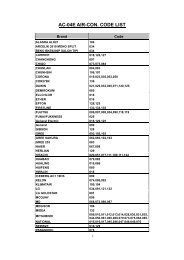computer
computer
computer
You also want an ePaper? Increase the reach of your titles
YUMPU automatically turns print PDFs into web optimized ePapers that Google loves.
“Little SAT lexicon”<br />
LNB, Universal Quattro<br />
Converter that has two separate outputs for polarity balance: linear vertical and linear horizontal. It is<br />
used in centralised intermediate frequency splitter systems, as well as for small or large networks.<br />
LNB, V/H<br />
LNB, which can distinguish between the polarity of the received channels according to voltage: 14 V<br />
for the horizontal channels 18 V for vertical channels or vice versa, according to make and model. By<br />
using voltage change, a V/H-LNB can use a single cable to transmit horizontal and vertical channels.<br />
LNB/LNC<br />
Low Noise Block Converter = a receive converter that converts the incoming signal into a lower<br />
frequency and amplifies it at the same time.<br />
MHz<br />
Abbreviation for MegaHertz. The unit of measurement for radio and TV transmission frequencies. One<br />
MegaHertz equates to one million complete oscillations per second.<br />
Modulator<br />
An electronic device that applies audio and visual signals to a carrier frequency and in effect produces<br />
a new signal. The modulator is built into the video recorder and satellite receiver in order to use the<br />
antenna cable as the connection with the TV equipment. In common-use satellite facilities the<br />
modulator is used to produce a TV channel with which to distribute a satellite programme<br />
simultaneously with terrestrial channels, without changing the network and subscriber sockets.<br />
MPEG<br />
Motion Picture Expert Group. A standard for digital compression of TV images. The MPEG-1 has been<br />
used for some time for optical discs and its quality is comparable with a middle range videocassette.<br />
MPEG-2 has better characteristics and is suitable for broadcast transmissions.<br />
MPEG-2<br />
Is codified under ISO IEC Standard 13818. The system codification is defined in Part 1, the video<br />
codification in Part 2 and the audio codification in Part 3.<br />
Multifeed<br />
A technology that enables several satellites to be received with one fixed antenna. The system is based<br />
on “defocusing” the parabolic reflector as several LNBs are applied.<br />
Offset<br />
A parabolic bowl that is a section of a larger bowl, where the focal point has been shifted from the<br />
centre and hence away from the signal stream hitting the bowl.<br />
OSD<br />
On Screen Display. The display of commands and data lists in menu form on the TV screen, whereby<br />
all the functions of the equipment can be controlled and programmed using the remote-control device.<br />
Parabolic antenna<br />
Antenna, similar to a concave mirror, that concentrates incoming signals to a focal point, where the<br />
LNB supply feedhorn is located.<br />
Pay TV<br />
Subscription, or Pay TV, is TV broadcasts that can only be received on condition of payment and are<br />
financed by the receiver. The majority of programmes are either partially, or completely encoded<br />
(scrambled) and therefore only receivable with a special decoder.<br />
Polarisation<br />
A level, that corresponds to the electrical components of an electromagnetic wave. Satellite<br />
transmissions use two separate levels, the horizontal and vertical, to make better use of the frequency<br />
spectrum. The basis of the system is that the bands of two adjacent channels can partially overlap.<br />
The possible resultant interference can be prevented if the channels are differently polarised. Using this<br />
system, the ASTRA satellite is now able to transmit more than 50 TV channels that lie adjacent to each<br />
other and partially overlap, without any interference arising between any of them.<br />
Receiver<br />
Processes the signals coming from the LNB for the TV equipment.<br />
Reflector / Mirror<br />
Element of the parabolic antenna that concentrates the received energy onto the focal point.<br />
Satellite receiver<br />
A device that, in conjunction with an antenna, converts a received signal into a form suitable for TV<br />
equipment.<br />
Scart plug<br />
Plug connection on TV equipment, video and satellite recorders, for the transfer of video and audio<br />
signals.<br />
Service Information<br />
Digital data describing the distribution system, content and programming of a broadcast datastream,<br />
etc. The information includes MPEG-2 PSI along with independently defined extensions.<br />
www.vivanco.com<br />
Signal<br />
General description for data, information, audio or video, the content of which has been electronically<br />
altered so that it can be transmitted over distances or to link various pieces of apparatus.<br />
SimulCrypt<br />
DVB SimulCrypt refers specifically to the interoperability requirements between two or more frontend<br />
CA systems.<br />
Single band LNB<br />
Standard LNB suitable for the reception of the single frequency band (FSS, DBS or SMS) without<br />
switching polarity level.<br />
Splitter<br />
Signal splitter required to divide the output signal of a device (LNB or amplifier) to several receivers.<br />
Spot<br />
Coverage area of the satellite that is limited to a small spot on the earth's surface.<br />
Teletext<br />
An information service transmitted along with a TV programme that can only be received by suitably<br />
equipped television equipment. Information can be displayed on a maximum of 999 pages, which can<br />
be viewed page by page on television equipment with the Videotext facility. Some television equipment<br />
stores a set number of pages so as to make them directly accessible.<br />
Terrestrial<br />
This refers to all surface broadcasting with the exception of space and astronomical transmissions.<br />
Using a “normal” (terrestrial) house antenna television and radio programmes can be received.<br />
Transmission loss<br />
Reduction of the signal level at each output, e.g. we split as within receiver equipment.<br />
Transponder<br />
Signal amplifier. Each satellite carries a specific number of transponders. The transponder can transmit<br />
one (ASTRA), or in some cases two (Intelsat and EUTELSAT) TV channels. For a digital transmission<br />
system, a single transponder can carry more than two radio or TV channels. The transponder receives<br />
a signal in a particular frequency from the earth and retransmits it with a different frequency back to<br />
earth again.<br />
TV Band<br />
Frequency band between 40 and 860 MHz, in which terrestrial TV channels are broadcast.<br />
UHF<br />
Ultra High Frequency. Frequencies between 300 and 3000 MHz that are also used for terrestrial<br />
television broadcasting between channel 21 (470 MHz) and channel 69 (860 MHz).<br />
Upgrade<br />
English expression for equipping an operating system, or electrical apparatus (<strong>computer</strong>, SAT receiver,<br />
etc.), so that it conforms to the latest technical developments. Upgrading means exchanging a circuit,<br />
card or other item, or the addition of other items in an already functioning equipment to make it more<br />
powerful.<br />
VHF<br />
Very High Frequency. Frequencies between 30 and 300 MHz, for radio as well as television<br />
broadcasting.<br />
Video<br />
Electronic information that is produced when a real picture is converted into an electronic signal. The<br />
video signal has certain specific characteristics so that it conforms to the worldwide standard for<br />
image transmissions<br />
Others<br />
145



